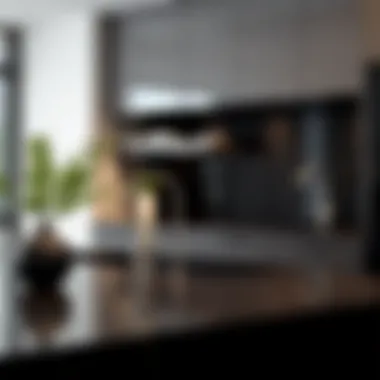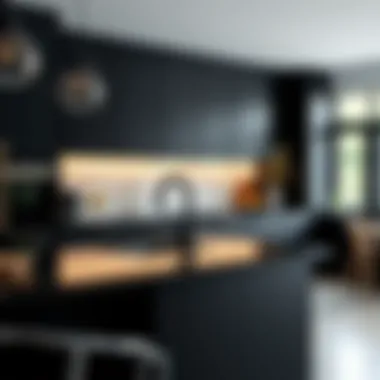Trends and Materials for Black Kitchen Countertops


Intro
In the realm of kitchen design, black countertops have risen to become a darling of both homeowners and designers alike. Their appeal lies not only in their elegant appearance but also in their versatility across various design schemes. Whether you’re decorating a modern space or trying to achieve a timeless look, black countertops bring a certain depth and richness that cannot be matched. They serve as a dramatic backdrop, allowing other elements in the kitchen to shine without overpowering the overall aesthetic.
This article aims to provide a well-rounded exploration of black kitchen countertops. It covers the trending materials and textures that are making waves, along with practical tips for selecting the right options for your space. From granites to quartz, and even the increasingly popular concrete, the choices available to those looking to install or upgrade their kitchen surfaces are plentiful.
Expect to glean insights into the latest trends in color palettes that pair effortlessly with black countertops. You'll also find guidance on how to maintain these surfaces while ensuring they continue to dazzle for years to come. This goes beyond mere aesthetics; it considers the functionality that these materials bring to everyday cooking and social gatherings alike.
As we unfold the narrative, we'll consider not just the visual impact of black countertops but also how they can enhance the overall ambiance of your culinary space. By balancing practical considerations with design inspirations, this guide will be an invaluable resource for anyone looking to elevate their kitchen’s look while ensuring its utility remains intact. Let's delve deeper and uncover the nuances of black kitchen countertops.
Preface to Black Kitchen Countertops
Black kitchen countertops have steadily gained traction in both residential and commercial spaces. Their timeless appeal and versatility make them a choice for anyone looking to elevate their kitchen’s aesthetic. Whether you are a homeowner looking to remodel or a designer crafting a culinary space, understanding the nuances of black countertops is crucial. This section offers insights into why these surfaces are becoming increasingly important in modern décor.
The Growing Popularity of Black Countertops
In the era where design trends obscure traditional lines, black kitchen countertops have emerged as a steadfast favorite. This shift towards darker hues speaks volumes about contemporary sensibilities—leaning towards minimalist designs that emphasize simplicity and elegance. No longer confined to only luxury homes, black countertops are now commonplace, gracing kitchens of all styles.
A significant factor in their rise is the prevalence of open-concept living. As kitchens move from isolated rooms into the forefront of home design, the need for surfaces that not only serve practical purposes but also act as focal points has become apparent. Black countertops provide a striking contrast against lighter cabinetry and walls, drawing the eye and creating a dramatic flair that can redefine a space.
Moreover, brands like Caesarstone and Silestone have introduced various shades and textures that allow homeowners to curate their environment genuinely. The ease of pairing black surfaces with a variety of materials—like wood, stainless steel, and vibrant tiles—makes them a flexible option in kitchen design. They resonate particularly well with modern, industrial, and even farmhouse aesthetics, blending seamlessly while providing that bold splash of style.
Aesthetic Significance in Modern Design
The choice of black countertops goes beyond mere utility; it embodies a sense of sophistication. In the context of modern design, they hold an aesthetic weight that can transform a mundane kitchen into a chic culinary haven. The richness of black surfaces creates a visual contrast that can enhance perceptions of depth and dimension in the overall space.
Incorporating black countertops allows for bold design statements. They can frame a room’s color palette or be the backdrop that elevates accompanying elements, such as brass fittings or colorful kitchenware. This juxtaposition often brings a sense of balance, allowing homeowners to play with light and shadow in a way that feels intentional and organic.
Additionally, black is a color of refinement. Designers today often use it to evoke feelings of luxury and power in spaces that might otherwise feel underwhelming. This capability makes black surfaces not just an option but a design strategy in kitchens aimed at making a lasting impression.
"Black countertops harmonize with an array of styles, transforming kitchens into elegant expressions of the homeowner's taste."
Material Varieties
Understanding the material varieties available for black kitchen countertops is crucial for homeowners and designers alike. Each material offers its own unique benefits and aesthetic charm, influencing not just the look of the kitchen but also its functionality and durability. The choice of material can greatly determine the overall vibe of a space, pushing the boundaries of creativity while harmonizing with personal style. Whether aiming for dramatic sophistication or understated elegance, knowing the nuances of each material helps in making informed decisions.
Granite: Natural Elegance
Granite countertops bring a sense of natural beauty to the kitchen. Known for their unique patterns and speckles, every slab has its own story to tell, making your countertop completely one-of-a-kind. The durability of granite is quite remarkable; it’s resistant to scratches and heat, which is a blessing for those who love to cook. What’s more, maintaining granite is fairly straightforward—regular sealing helps to keep it looking pristine.
When choosing granite, consider its density and how it fits in your kitchen design. For instance, a highly polished granite can give a sleek modern feel, while a honed finish may offer a softer touch.
Quartz: Engineered Efficiency
When talking about black kitchen countertops, quartz definitely deserves a spotlight. This material consists of crushed natural stone blended with resin, resulting in a highly durable surface with fewer porous imperfections. Homeowners appreciate quartz for its ability to mimic the beauty of natural stone without the same maintenance fuss.
Versatility is another feather in quartz's cap. It comes in a wide array of patterns and colors, giving freedom to match it with various kitchen styles, from contemporary to farmhouse. Just be mindful—excessive sun exposure might fade its vibrancy over time.
Marble: Timeless Luxury
For those who want to inject luxury into their kitchens, marble ranked high on the list. Its classic appearance and elegant veining can elevate the feel of any cooking space. However, marble does come with a few caveats. While it's heat resistant, it's more susceptible to scratching and staining compared to granite or quartz, meaning it requires some extra care.


If you lean toward a more upscale look, integrating black marble with white veining can create a stunning focal point in the kitchen, setting a tone of sophistication.
Laminate: Budget-Friendly Alternatives
If you’re not looking to break the bank but still want stylish countertops, laminate surfaces are a great choice. They are available in an impressive selection of colors and designs, including realistic black stone appearances. Their affordability makes them popular among budget-conscious homeowners.
One significant benefit is that laminate is lightweight and easier to install compared to heavier materials like granite or marble. On the downside, they are more susceptible to heat and scratches, which may necessitate more careful use. With proper care, laminate can still look fresh and appealing for many years.
Concrete: Industrial Appeal
Lastly, we have concrete countertops, which offer a unique edge in terms of design. These can be customized in shape, color, and finish, providing a perfect fit for both modern and rustic interiors. From an aesthetic perspective, they might not scream luxury, but they certainly convey a sense of contemporary industrial appeal.
Though concrete is incredibly sturdy and can withstand heavy use, it can be prone to cracking if not properly installed. Moreover, sealing is required to maintain its surface, but the flexibility in design options often makes it a worthwhile investment.
"Choosing the right material for a black countertop can set the stage for your kitchen's character—think durability and style."
In summary, the material you choose for black kitchen countertops is not simply about aesthetics; it influences durability and maintenance too. Each option presents its own set of factors to consider, making it essential to weigh the pros and cons before making your choice.
For more detailed comparisons on materials, consider visiting trusted sources like Wikipedia, or engaging in discussions on platforms like Reddit for community insights.
Design Considerations
Designing a kitchen involves more than just selecting materials; it’s about creating an atmosphere that merges functionality with aesthetics. Black kitchen countertops, often underscored by their striking visual appeal, require thoughtful design considerations for them to truly shine in a culinary space. This section examines how various elements such as fixtures, light balance, and texture play crucial roles in enhancing the overall kitchen environment.
Matching Fixtures and Fittings
When it comes to black countertops, the choice of fixtures and fittings can make or break a design. Selecting materials that harmonize with the deep tones of the countertop is paramount. For instance, stainless steel tends to offer a modern contrast that highlights the sleekness of black granite or quartz. On the other hand, brass or gold fittings can infuse warmth and an element of luxury, creating a more inviting atmosphere.
Here are a few key aspects to consider:
- Color Harmony: Fixtures should complement the shades of the black countertops, maintaining a cohesive look.
- Material Compatibility: Choose materials that not only match in color but in style and finish as well.
- Functionality vs. Aesthetics: While the visual aspect is crucial, fixtures should also serve practical purposes effectively.
By closely coordinating these elements, homeowners can craft a kitchen that reflects personality while ensuring every inch serves a purpose.
Balancing Light and Dark Elements
Creating a balanced visual palette is vital when incorporating black countertops into kitchen design. These surfaces absorb light; therefore, it’s essential to counteract that effect with the right lighting choices and surrounding elements.
Now, you should:
- Incorporate Lighter Materials: Pair black countertops with light-colored cabinets or walls to prevent the space from feeling too dark. Soft whites or pastel shades act well to break the monotony.
- Use Strategic Lighting: Opt for under-cabinet lighting or pendant fixtures that can brighten the surfaces and add illumination.
- Highlighting Color Variations: Introducing colored accents—like vibrant dishes or plant life—can create a dynamic interplay against the understated backdrop of black.
As a result, designers can achieve a striking balance between dark and light, ensuring that the kitchen feels inviting and balanced rather than closed in.
Utilizing Texture for Depth
Texture is often the unsung hero in interior design. When using black countertops, incorporating varied textures adds layers of interest and richness to the overall aesthetic. Texture can make a flat design feel three-dimensional and vibrant. Here’s how it can be executed:
- Mix Materials: Combining black countertops with textured materials like reclaimed wood or woven fabrics can create a visually captivating experience.
- Accent Pieces: Integrating textured accessories such as rough-hewn stools or patterned curtains can soften the dominant black surfaces.
- Stone or Composite Variations: Consider opting for black counters that come with unique finishes—such as honed or leathered textures—which can enhance the tactile experience.
In summary, engaging with texture not only accentuates the black countertops but also contributes to a sophisticated layer of complexity in design. Achieving depth in a kitchen space can ultimately elevate it from ordinary to extraordinary, resonating with those who inhabit it.


"A well-designed kitchen reflects careful planning of aesthetic detail, ensuring each element resonates with the others, creating a unified space."
By paying attention to these intricate design considerations, homeowners can create kitchens that are as inviting as they are functional.
Practical Aspects
When selecting black kitchen countertops, the practical aspects should not be overlooked. These features go beyond aesthetics, directly impacting the longevity, utility, and overall enjoyment of a kitchen space. Homeowners and designers alike must consider durability, maintenance, heat and scratch resistance, and cleaning protocols, as they make their choices. These elements will ultimately determine how well the countertops stand the test of time and fit into your lifestyle.
Durability and Maintenance Requirements
Durability is key when investing in black kitchen countertops. Surfaces that can withstand daily wear and tear are crucial, especially in busy households. Granite, for example, is known for its robust nature. Its resilience against chipping and cracking makes it a favored choice. However, it requires periodic sealing to keep it looking sharp and to prevent stains from food and liquids.
On the other hand, quartz countertops offer an engineered option that combines beauty and durability. Thanks to the resins used in its manufacturing, quartz is non-porous, which means it's less prone to staining and doesn't require sealing, simplifying maintenance further. For practical buyers, this feature often sways their decision, especially if they have a hectic lifestyle.
"Many homeowners underestimate the importance of understanding the long-term maintenance needs of their countertops. The right choice can save a lot of headache down the line."
Heat and Scratch Resistance
In a kitchen, the ability to withstand heat and scratches can be a deal breaker. Black countertops made of materials like granite can resist high temperatures, but homeowners should still use trivets to protect them from extreme heat. Quartz, while also heat-resistant, can discolor if subjected to prolonged exposure to high temperatures. Knowing these nuances helps avoid unnecessary damage.
Laminate and concrete countertops may fall short in this category. Laminate can easily scratch, while concrete may chip if not properly treated. Therefore, it's vital to think about how your countertops will be used and prepare accordingly. Understanding the heat and scratch resistance can ensure you make a smart investment that will last.
Cleaning and Care Tips
Maintaining the appeal of black kitchen countertops doesn't have to be a chore. Regular cleaning is essential, but the method will differ based on the material. Here are some practical tips:
- Granite: Use a pH-balanced cleaner specifically designed for stone. Avoid harsh chemicals that may damage the sealant.
- Quartz: A simple mixture of soap and water works wonders. No need for specialized cleaners.
- Marble: Be cautious with acidic substances; they can etch the surface. It might require unique cleaning solutions to keep it pristine.
- Laminate: Gentle sponges will do, but steer clear of abrasive pads to ensure longevity.
- Concrete: Sealing is vital; follow up with a cleaner that's safe for sealed surfaces to retain its beauty.
Ultimately, understanding these practical aspects helps in choosing the right black kitchen countertops tailored to your needs and lifestyle.
Trends in Black Kitchen Countertops
The world of kitchen design moves at a frenetic pace, yet black kitchen countertops seem to be a prevailing choice in many modern homes. This enduring trend is not just a passing fad; it reflects a shift in aesthetic values and practical considerations of homeowners and designers. In a space where culinary creativity happens, the color black brings depth, sophistication, and flexibility to any kitchen environment. Understanding these trends allows you to navigate the complex landscape of kitchen design effectively, ensuring that your choices complement the overall cooking and living spaces.
Embracing Mixed Materials
Gone are the days when kitchens were confined to one type of material. Today, a popular trend is the synergy between various materials creating a cohesive look. For instance, pairing black granite countertops with wooden cabinets offers a charming contrast that balances warmth and sleekness. Metal accents, such as brass or stainless steel fixtures against a black backdrop, also create a striking visual. The real beauty lies in how these materials can interplay to highlight individual features without overshadowing the overall kitchen design.
When utilizing mixed materials, consider these key points:
- Contrast: Use textures that oppose each other. A glass backsplash can enliven a matte black countertop, for instance.
- Balance: Ensure that no single material becomes too dominant. It can lead to visual clutter, making the kitchen feel chaotic rather than inviting.
- Functional Cohesion: Each material should not only look good together but also serve a purpose. For example, complementing a hard surface with softer textures can enhance comfort and usability.
Monochromatic Schemes in Kitchen Design
The monochromatic scheme can be a game-changer in kitchen aesthetics, especially when using black countertops. This design philosophy allows for a clean, uncluttered look that feels intentional and polished. By using varying shades of black and grey throughout the design—think black appliances, dark cabinetry, and shadowy tile flooring—you create a seamless flow that can make the space appear larger and more serene.
Implementing a monochromatic scheme can also do wonders for emphasizing light sources. When wisely illuminated, black countertops can reflect light subtly, enhancing their depth and allure. Here are some tips to consider:
- Layering Textures: Incorporate varied finishes. A matte black countertop accompanied by glossy black cabinetry creates an intriguing visual tension.
- Accent Colors: Use a strategic accent color to break the monotony—think of deep greens or dark blues that can pop against the black.
- Continuous Surfaces: An open floor plan can benefit from maintaining a consistent color palette from countertops to flooring, ensuring continuity through the design.
Innovations in Surface Technology


One cannot discuss trends in black countertops without mentioning the technological advances that have dramatically altered our options. Innovations in surface materials mean that homeowners and designers have more choices than ever. Technologies such as nanotechnology make countertops more resistant to stains and scratches. Meanwhile, advances in manufacturing processes allow for more intricate designs and cuts that elevate the aesthetic appeal of black surfaces.
Durability and ease of maintenance are also on the rise. Because of improved formulations, quartz countertops, for instance, offer a strikingly elegant black appearance while being non-porous and resistant to etching. The new technologies allow for:
- Varied Patterns: You now can find black surfaces with unique vein patterns resembling marble, offering aesthetics without compromising on endurance.
- Smart Integration: Features like integrated charging stations or sinks seamlessly incorporated into the countertop surface reflect the growing demand for kitchen efficiency and modernity.
- Eco-Friendly Choices: New materials are being designed with sustainability in mind, appealing to environmentally-conscious homeowners.
These trends will undoubtedly continue to evolve, but their core principles of elegance, functionality, and style will remain essential in highlighting black countertops in kitchen designs.
Cultural Influences on Design Choices
Understanding the cultural influences on design choices is essential when diving into the realm of black kitchen countertops. These countertops don’t just serve a practical function; they resonate with history, identity, and regional preferences that shape how we view and use our culinary spaces. Each culture brings a unique perspective that influences color, material, and even the arrangement of the kitchen. Therefore, grasping these subtleties helps in elevating design decisions from mere aesthetics to meaningful expression.
Historical Context of Countertop Materials
Historically, the materials used for countertops were dictated by availability, craftsmanship, and the prevailing design trends of the time. For instance, in ancient Egypt, stone was preferred due to its durability and the exalted status associated with it. Fast forward to the Renaissance period, and marble emerged as the epitome of luxury, often seen in affluent households. Each epoch offered different materials, but black natural stone, whether granite or basalt, has consistently signified opulence and resilience.
- Medieval Kitchens: Utilized wooden tables predominantly, which were later replaced by stone as the culinary arts evolved.
- Industrial Revolution: Brought forth materials such as cast iron and eventually granite as mass production made these once elite materials accessible.
- 20th Century: The rise of modernism shifted tastes towards minimalist materials, with quartz and laminate vying for attention.
With time, the perception of black countertops has evolved, often seen as a bold choice in kitchens that echo the modern lifestyle. Their popularity in specific cultures reflects broader trends in societal values, emphasizing durability coupled with a sense of sophistication.
Regional Variations in Preference
Cultural variations also play a pivotal role in the choices of kitchen countertop materials. Across various regions, preferences reflect local materials, climate, traditions, and even culinary practices.
- Northern Europe: Black granite is sought after for its toughness and ability to withstand harsh winters. Its subtle elegance complements the Scandinavian minimalistic approach.
- Mediterranean Regions: In Spain or Italy, there’s a penchant for darker marbles, capturing warmth and richness that resonates with the vibrant culinary traditions.
- Asia: With a different culinary approach, many Asian kitchens prefer engineered materials, like quartz, due to their low maintenance and aesthetic versatility. Black finishes often symbolize simplicity and elegance, harmonizing with their minimalist philosophies.
- North America: Here, preferences blend practicality with aesthetics. Black countertops in urban settings may lean towards quartz for ease of cleaning, while rural areas may favor natural stones that resonate with the rustic charm.
In summary, black kitchen countertops are not merely a design element but an intricate tapestry woven from cultural histories and regional idiosyncrasies. They reflect who we are and what we value in our living spaces. As trends evolve, understanding these influences allows homeowners and designers to create kitchens that tell stories, echoing both personal and collective identities.
Finale
The conclusion of this article brings together the key threads woven throughout the exploration of black kitchen countertops. By consolidating the insights regarding materials, trends, and aesthetic implications, we can appreciate the multifaceted role that these surfaces play in modern kitchen design. Black kitchen countertops are not merely functional; they serve as a bold statement, reflecting personal style and enhancing the overall ambiance of culinary spaces.
Summarizing Key Points
To summarily restate the central themes:
- Growing Popularity: Black countertops have surged in popularity, resonating with both contemporary and traditional designs.
- Material Variety: Options such as granite, quartz, marble, laminate, and concrete showcase varied aesthetics and practical benefits. Each material pairs differently with kitchen elements, offering diverse visuals and functionalities.
- Design Considerations: Effective design involves harmonizing black surfaces with fixtures, playing with light and shadow, and using textures to create layering in visual appeal.
- Durability and Practicality: The practicality of black countertops, primarily their resistance to wear and ease of maintenance, position them as top picks for homeowners.
- Trends: Current design trends prioritize mixed materials and monochromatic schemes, reflecting a shift towards sophistication and modernity.
This summary underscores that choosing a black kitchen countertop is not merely about the color; it embodies choices grounded in theme, practicality, and style.
Future Implications for Design Choices
Looking forward, black kitchen countertops will likely remain a staple in design discussions. As trends evolve, the push for personalized, bespoke spaces will inform future innovations in materials and technology.
Consider the implications of:
- Sustainable Materials: With growing environmental awareness, the shift towards sustainable and eco-friendly materials may lead to innovative black countertop solutions that still meet aesthetic desires.
- Smart Tech Integration: The integration of technology in kitchen design might evolve, leading to smart surfaces that feature built-in appliances or connectivity options, enhancing functionality.
- Cultural Infusion: As global influences permeate design, the historical and regional preferences for black kitchens could inspire hybrid styles, enriching the American kitchen landscape.
The role of designers and homeowners will, therefore, evolve into curators of style, where the decisions made today will lay the groundwork for tomorrow’s kitchens.
In summary, the choice of black countertops represents more than a trend; it encapsulates a fusion of style, practicality, and forward-thinking that resonates with homeowners and designers alike.
"Design is not just what it looks like and feels like. Design is how it works." - Steve Jobs
For more insights, consider visiting sources such as Wikipedia, Britannica, and community discussions on Reddit.
By synthesizing the information provided, homeowners and design professionals can confidently make informed choices that resonate with their unique tastes and practical needs.



